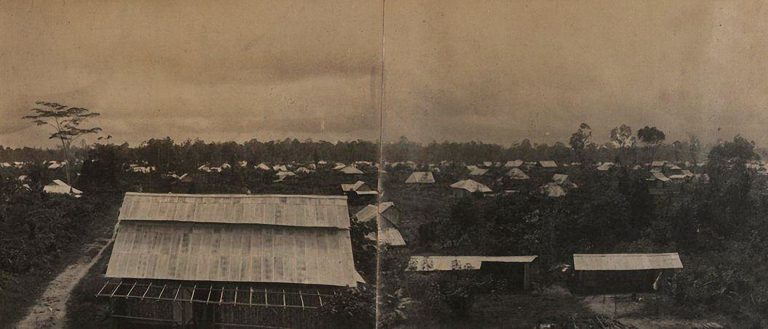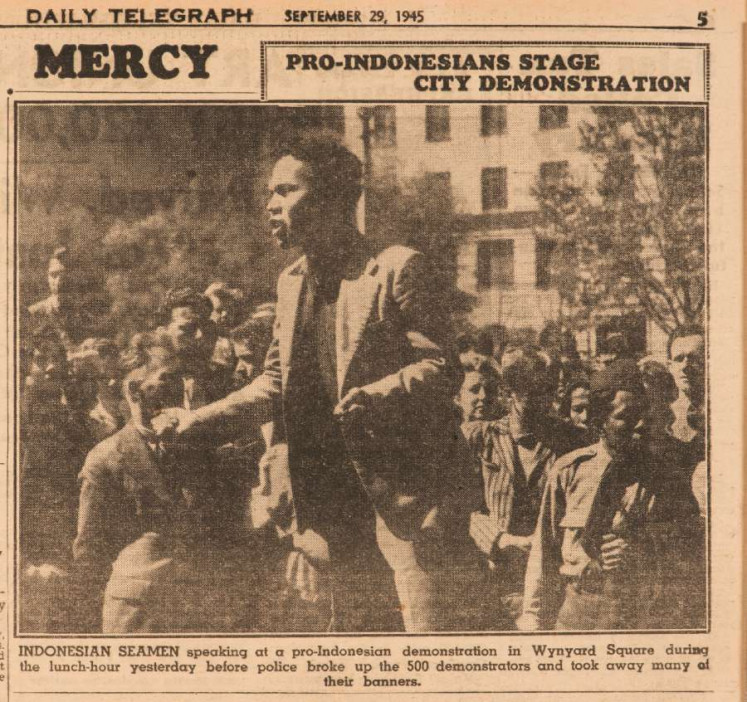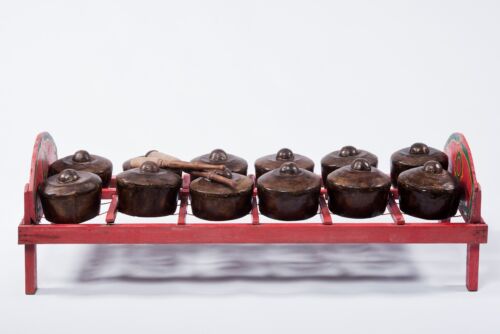The Digulists

This story is about the Digulists – prisoners of war who were captured after the Indonesian uprising of 1926/27. These political prisoners were transported to a specially established concentration camp in Tanah Merah on the Digul River in Dutch New Guinea. By the start of WWII, a large number of these political prisoners from the Netherlands East Indies (NEI) were still held here. The camp resembled a large village, complete with shops, football clubs, theatre, etc. As it was in the middle of an inaccessible jungle, security was limited, making escape nearly impossible.
While the southern part of Dutch New Guinea was not occupied by the Japanese, the Dutch were concerned about their advance. The Dutch, Australians, and later the Americans used Merauke, the capital of South Dutch New Guinea, as an important military base. However, in 1942/43 this area was not yet secured. If the Japanese were to occupy this part of the island, the Dutch worried that the political prisoners held in Tanah Merah might band together with the Japanese in exchange for recognition of greater independence.
In 1943, the Dutch decided to transport these prisoners to Australia. This was the start of an important episode that brought the political situation of the Dutch colony to the attention and scrutiny of the Australians. Earlier, a few of the prisoners had escaped and fled to Australia across the Arafura Sea that separates the two countries. Australia was therefore aware of the existence of this camp. The escapees had been sent back to the camp. Australia supported Dutch rule of NEI and was not interested further in the affairs of their northern neighbour.
The Dutch considered it safer to bring the political prisoners to Australia and were supported in this by the Americans. This support was used by the Dutch to lobby the Australian Government for permission to bring them to Australia. The White Australia policy stood in the way, but eventually, the prisoners were allowed to be brought to camps outside the main cities. To the Australians, these prisoners were presented as dangerous guerrillas rather than political prisoners.
Vice Governor of NEI, Charles van der Plas, was sent to Merauke to organise the evacuation. He had to travel 200 km over the Digul River to Tanah Merah – deep into the mosquito-infested jungle. The prisoners had no idea that there was a world war going on and that the Japanese had taken over most of NEI. During the evacuation of the camp, a few old and sick prisoners were left behind as the Dutch reasoned that they would be of no use to the Japanese.
Prisoners of Tanah Merah included Mohammad Hatta and Sutan Sjahrir, who later became the first vice president and premier of the Indonesian Republic. Interestingly, after the invasion of NEI by the Japanese, Dutch Governor van Mook offered Sjahrir – seen as a moderate nationalist – passage to Australia. Sjahrir indicated he would only accept this if the rest of the Tanah Merah prisoners were set free, which of course did not happen at that stage.
The evacuation was a difficult and tedious affair. In all, 295 political prisoners plus another 212 women and children, as well as 40 guards, had to travel over the Digul River to Merauke. From there, they were flown to Horn Island by Dutch Catalina seaplanes. A group of 22 internees – most likely the most senior ones – were immediately transported on the Katoomba to Sydney. Non-internees (women and children) were brought by ship to Mackay, where they were accommodated.

The rest of the internees came to Australia cramped in the Dutch KPM steamer ‘Both’. After departing from Merauke, the ship docked for fresh supplies in the Queensland port of Bowen. From there, it travelled to Sydney, and after disembarking, the prisoners went to Central Station and were transported by train to Liverpool on the outskirts of Sydney. Others were transported further to the prisoners-of-war camp in Cowra. Here they became known as the “Digulists” (back in Tanah Merah all people, prisoners and non-prisoners, referred to themselves this way).
On their arrival in Australia, some of the prisoners had secretly been able to pass on notes to one of the workers on the wharf in Bowen, indicating who they were and where they came from. This person happened to be a trade unionist. Through this network, the note ended up in the hands of Mr. J.C. Henry, the Queensland State leader of the Communist Party of Australia, based in Brisbane. He personally took the note to Sydney. Many of the political prisoners were also communists, so there was an immediate kinship.
A second handwritten note from one of the original Indonesian railway strikers from 1926 – known to the Australians as Jo-Jo – reached the Civil Rights League in Sydney. This note mentioned the many sick (malaria) and asked for medical attention. (Jo-Jo suffered from tuberculosis and died soon after his arrival in Sydney). The information reached some of the Australian soldiers who, together with Dutch soldiers, were involved in guarding the camps where these political prisoners were held. Once the Australians had established that these people were no friends of the Japanese, food and fruit parcels as well as medicines were rapidly organised for them. Laura Gapp of the Civil Rights League alerted the Australian Government about this situation. While there was no instant result, a process was started that a few months later would lead to the release of the prisoners.
The Dutch had been less than honest when they informed the Australian authorities that these prisoners were enemies of the allied forces and therefore had to be treated as prisoners of war. When that turned out not to be true, the Dutch were forced by the Australian Government to transport the sick to the Dutch Princess Juliana Hospital in Turramurra.

It was clearly seen as inappropriate for Australia to jail political prisoners from another country. Soon after the release of the sick, the rest of the prisoners who were kept in Liverpool were also set free. Finally, on December 7th, 1943, the detainees in Cowra were also released. Many of the freed prisoners joined trade unions. The result of this was that more Australians – especially trade unionists – got a better understanding of the plight of the ‘Indonesians’.
Once freed, most of them went to a more climate-friendly North Queensland. Some worked on the sugar plantations, and others worked for the Dutch military forces in Mackay. It was here that they formed one of the first Indonesian Independence Committees in Australia, known as the Mackay Committee.
Some of them also ended up at Camp Columbia where they were given employment.
The Digulists would become the driving force behind the request for a boycott of Dutch ships (see Black Armada). With the Dutch NEI Government-in-exile now concentrated in Camp Columbia, Brisbane (Wacol), the central office for the Indonesian independence movement was also established in Brisbane to coordinate the various independence activities in Australia.
An interesting anecdote tells something about the social impact of the Digulists. It was advertised in the local Daily Mercury of 24 June 1944 that there was an upcoming soccer match between Mackay and the Javanese (Source Clogball).
The Gamelan Digul was brought to Australia

| When the concentration camp in Tanah Merah was evacuated, the prisoners brought with them to Australia a gamelan that had been constructed by them with the assistance of the Javanese court musician and political activist Pontjopangrawit, who had entertained at the court of king Paku Buwana X as a child. It was here that he learned how to build gamelans and became a sought-after teacher. He was imprisoned here from 1926 until 1932 but was later arrested by the Indonesian government during the 1965 revolution and died in custody. De camp doctor L.J.H. Schoonheyt mentions the gamelan. In translation: “Tanah Merah didn’t lack a gamelan (a Javanese drum orchestra) and this was especially in later years excellent. At the start they had to improvise, and it was made from empty tins of sardines and ‘patjols’, (stolen) blades from shovels. Later the prisoners were, at special festivities, allowed to borrow the gamelan from the military and it soon became clear that there were several excellent musicians amongst them. The native gamelan music fits much better with these people than the imported jazz music. Hopefully modern music will never replace it”. A gamelan is the traditional ensemble of musical instruments used mainly in Java and Bali, made predominantly of percussive instruments. The most common instruments used are metallophones played by mallets and a set of hand-played drums called kendhang which register the beat. In the case of the Gamelan Digul this one was made from prison materials including pans and utensils – it was taken by the “Digulists” to the Cowra POW camp and from here it was taken by some of the musicians to Melbourne, where it was used in performances during the war. On the repatriation of the Digulists, it was presented to the Museum of Victoria and ended up at Monash University; some pieces are now in the Australian Museum in Canberra. |
